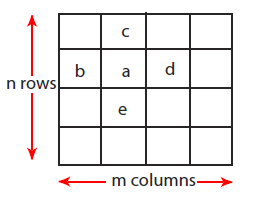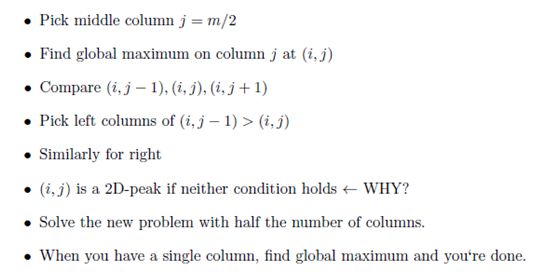为什么80%的码农都做不了架构师?>>> ![]()
MIT Introduction to Algorithms 学习笔记
http://ocw.mit.edu/courses/electrical-engineering-and-computer-science/6-006-introduction-to-algorithms-fall-2011/
整个课程分成8个部分:
Lecture 1: Introduction and Peak Finding
Peak Finder
在数组中找到一个峰值。
在数组中,如果b≥c且b≥a,那么b是一个峰值。如果i≥h,i是一峰值。
最简单的算法就是从数组的第一个元素和它的相邻的元素比较。算法运行时间为Θ(n)。
另外就是使用二分法:
算法运行时间为Θ(log2(n)):
Two-dimensional Version
在二维数组中如果a ≥ b, a ≥ d, a ≥ c, a ≥ e,那么a是峰值。
过程如下:
假设二维数组大小为(m,n),算法运行时间为Θ(n log n):
python代码:
def getMaxIndex(sList):
#print(sList)
iMax = 0
Max = sList[0]
for i in range(0,len(sList)):
if sList[i] > Max:
Max = sList[i]
iMax = i
return iMax
def isPeak(sList,iPos):
#print(sList)
sLen =len(sList)
if(1 == sLen):
return 0
elif(sLen - 1 == iPos):
if(sList[iPos] < sList[iPos - 1]):
return -1
else:
return 0
elif(0 == iPos):
if(sList[iPos] < sList[iPos + 1]):
return 1
else:
return 0
elif(sList[iPos] < sList[iPos - 1]):
return -1
elif(sList[iPos] < sList[iPos + 1]):
return 1
elif(sList[iPos] >= sList[iPos + 1] and sList[iPos] >= sList[iPos - 1]):
return 0
def PeakFinder_2D(sList2d,startPos,endPos):
rowLen = endPos - startPos + 1
tmpList1 = []
if(0 == rowLen):
return -1,-1,-1
iMid = int(rowLen / 2) + startPos
colLen = len(sList2d[iMid])
if(0 == colLen):
return -1,-1,-1
iMaxValInCol = getMaxIndex(sList2d[iMid])
for i in range(0,len(sList2d[iMid])):
tmpList1.append(sList2d[i][iMaxValInCol])
bIsPeak = isPeak(tmpList1, iMid);
print(iMid,iMaxValInCol,sList2d[iMid],bIsPeak)
if(0 == bIsPeak):
return iMid,iMaxValInCol,sList2d[iMid][iMaxValInCol]
elif(-1 == bIsPeak) :
return PeakFinder_2D(sList2d,startPos,iMid - 1)
elif(1 == bIsPeak):
return PeakFinder_2D(sList2d,iMid + 1,endPos)
return -1,-1,-1






